Abstract
The susceptibility to alpha/beta interferon (IFN-alpha/beta) or to gamma interferon (IFN-gamma) of various lymphocytic choriomeningitis virus (LCMV) strains was evaluated in C57BL/6 mice and in various cell lines. Anti-IFN-gamma treatment in vivo revealed that the LCMV strains Armstrong, Aggressive, and WE were most susceptible to IFN-gamma whereas Traub, Cl 13-Armstrong, and Docile were resistant. The same pattern of susceptibility to recombinant IFN-gamma was observed in vitro. In vivo treatment with anti-IFN-alpha/beta showed a sizeable increase in replication of Aggressive, Armstrong, and WE; effects were less pronounced for Docile, Cl 13-Armstrong, or Traub. Correspondingly, WE, Armstrong, and Aggressive were all relatively sensitive to purified IFN-alpha/beta in vitro, and Cl 13-Armstrong, Docile, and Traub were more resistant. Overall, there was a good correlation between the capacity of LCMV strains to establish a persistent infection in adult immunocompetent mice and their relative resistance to IFN-gamma and IFN-alpha/beta.
Full text
PDF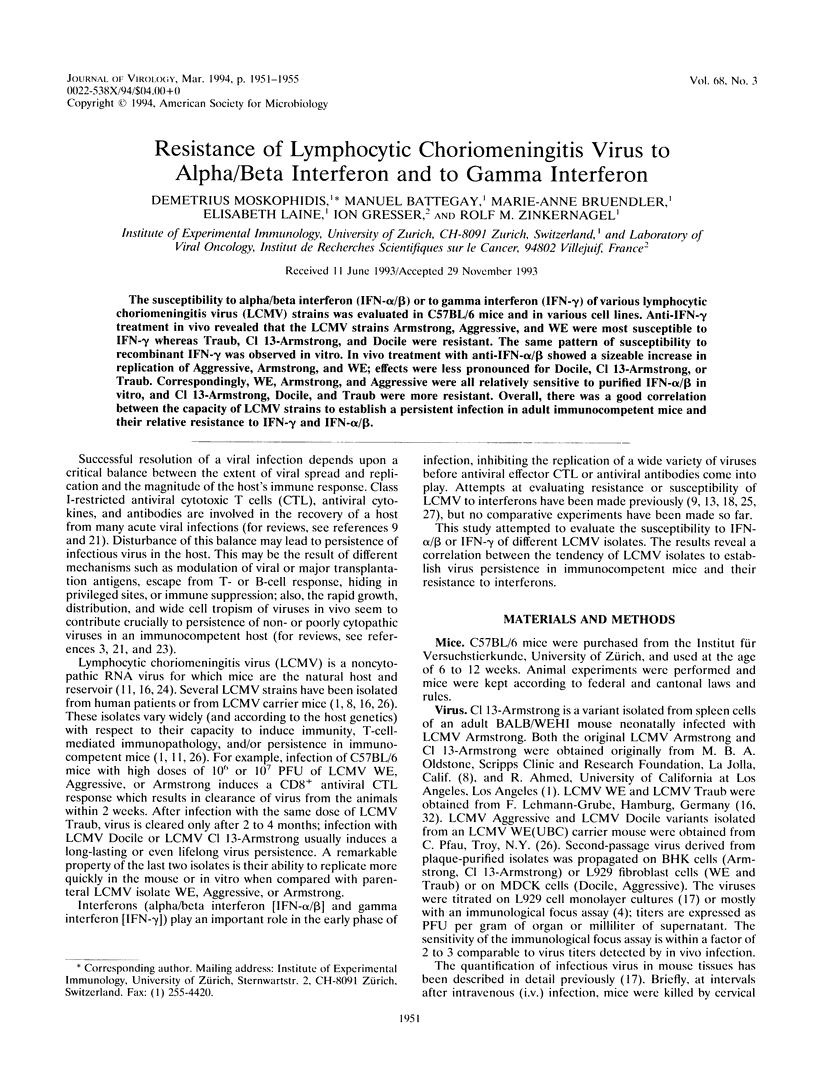
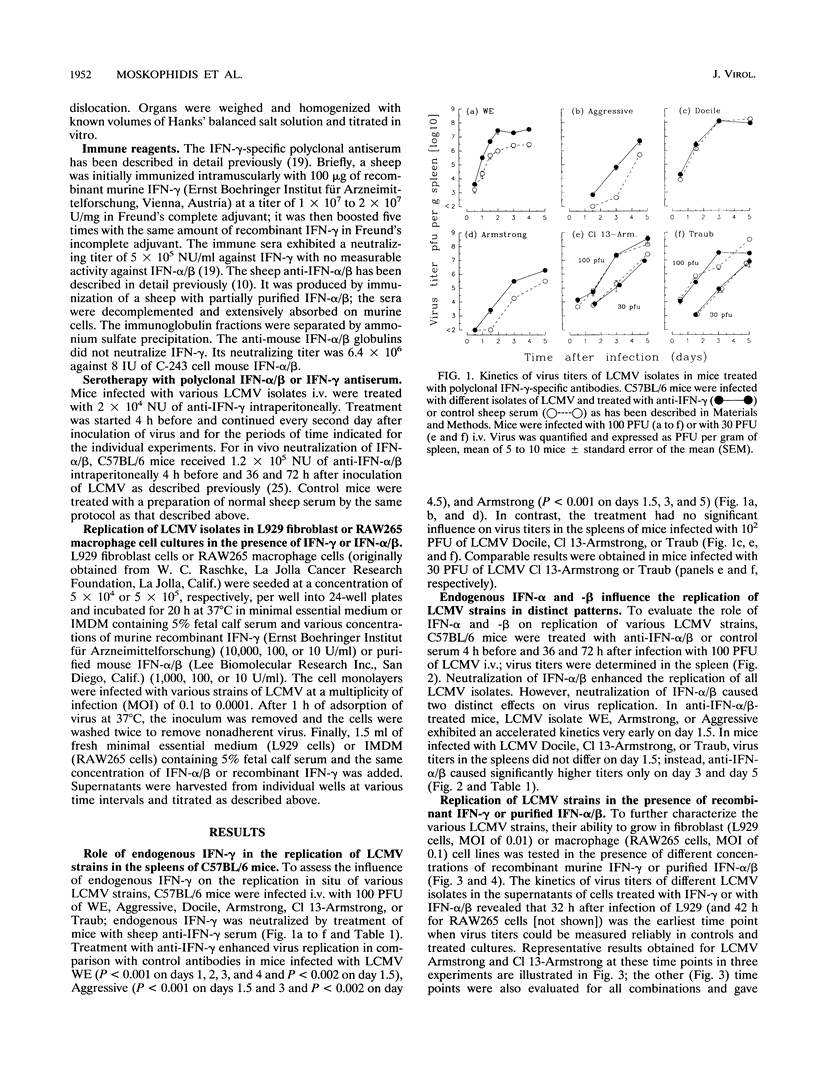
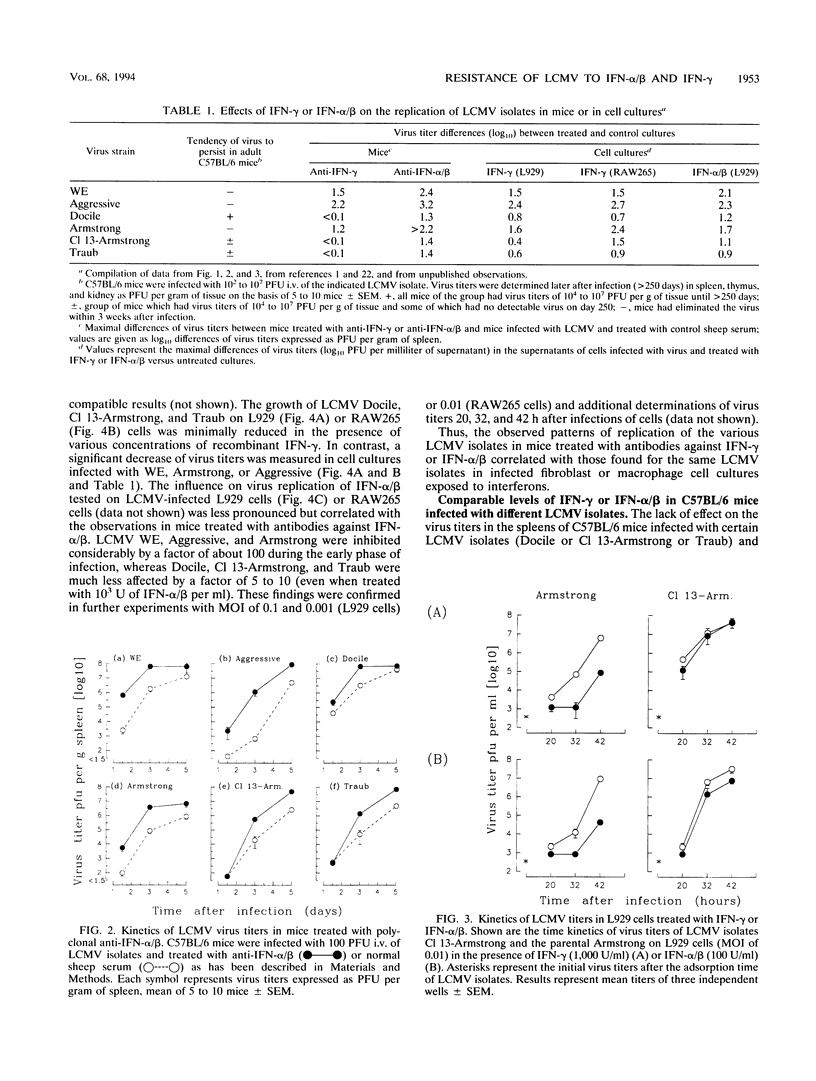
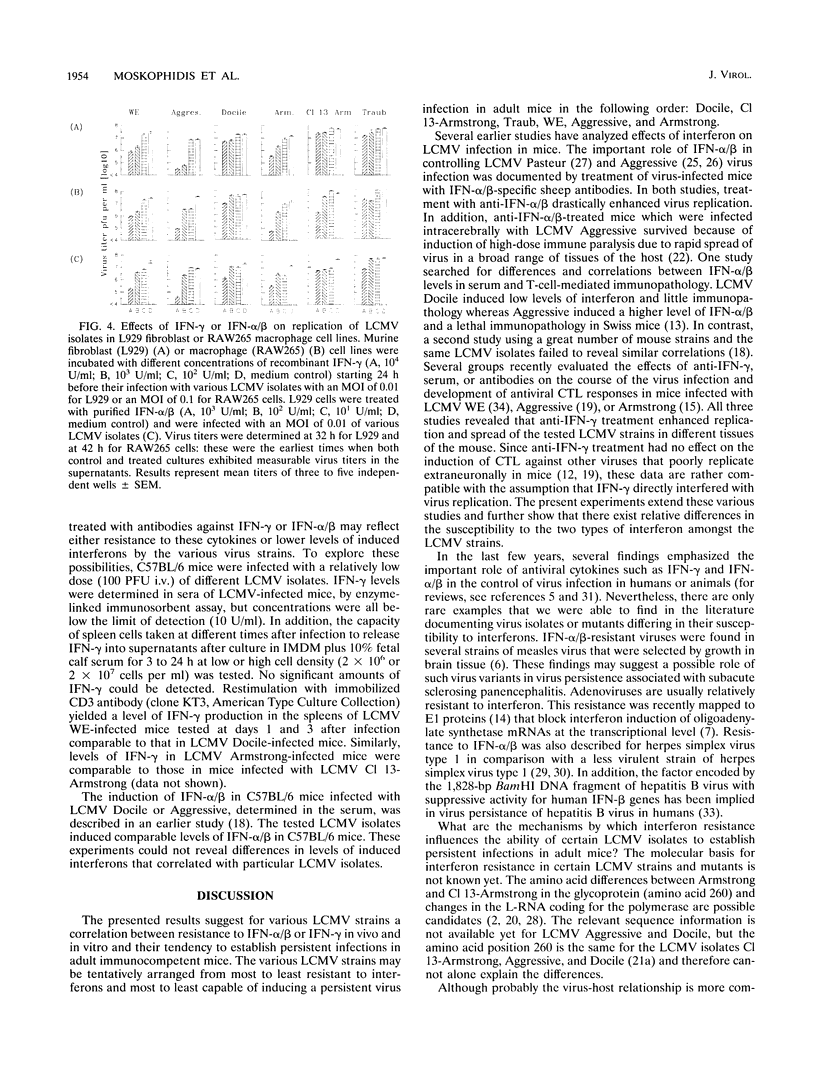
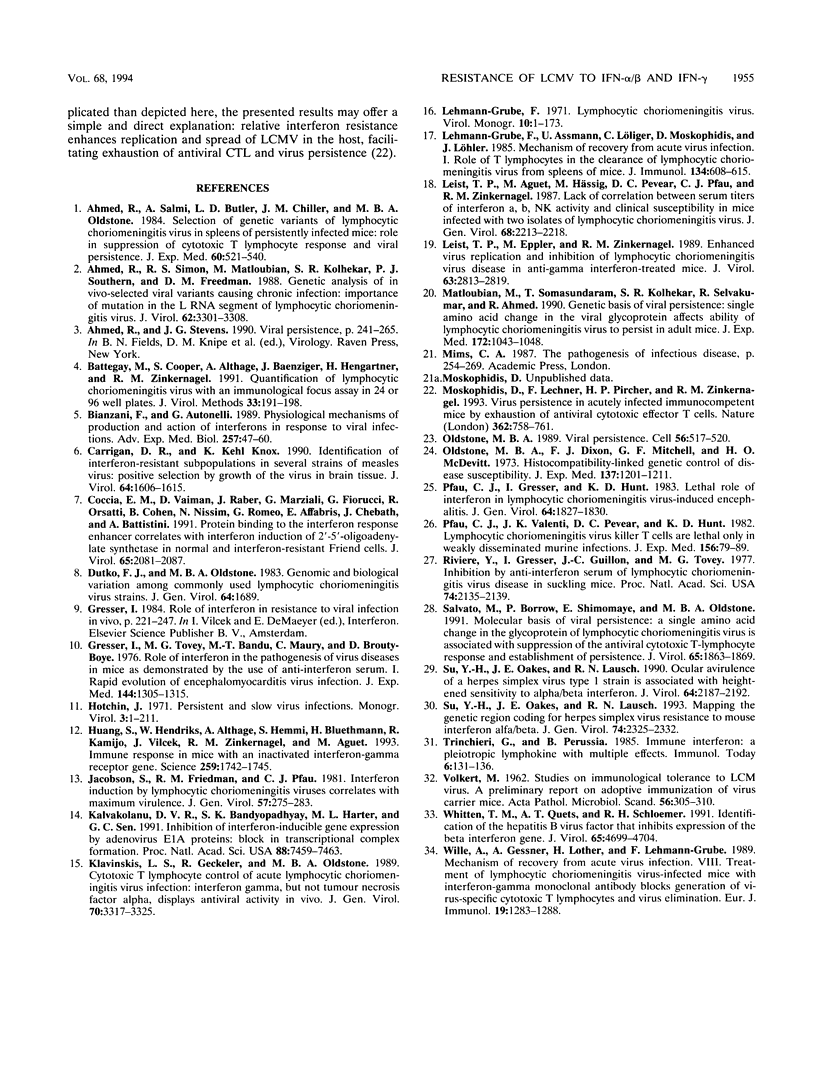
Selected References
These references are in PubMed. This may not be the complete list of references from this article.
- Ahmed R., Salmi A., Butler L. D., Chiller J. M., Oldstone M. B. Selection of genetic variants of lymphocytic choriomeningitis virus in spleens of persistently infected mice. Role in suppression of cytotoxic T lymphocyte response and viral persistence. J Exp Med. 1984 Aug 1;160(2):521–540. doi: 10.1084/jem.160.2.521. [DOI] [PMC free article] [PubMed] [Google Scholar]
- Ahmed R., Simon R. S., Matloubian M., Kolhekar S. R., Southern P. J., Freedman D. M. Genetic analysis of in vivo-selected viral variants causing chronic infection: importance of mutation in the L RNA segment of lymphocytic choriomeningitis virus. J Virol. 1988 Sep;62(9):3301–3308. doi: 10.1128/jvi.62.9.3301-3308.1988. [DOI] [PMC free article] [PubMed] [Google Scholar]
- Battegay M., Cooper S., Althage A., Bänziger J., Hengartner H., Zinkernagel R. M. Quantification of lymphocytic choriomeningitis virus with an immunological focus assay in 24- or 96-well plates. J Virol Methods. 1991 Jun;33(1-2):191–198. doi: 10.1016/0166-0934(91)90018-u. [DOI] [PubMed] [Google Scholar]
- Carrigan D. R., Knox K. K. Identification of interferon-resistant subpopulations in several strains of measles virus: positive selection by growth of the virus in brain tissue. J Virol. 1990 Apr;64(4):1606–1615. doi: 10.1128/jvi.64.4.1606-1615.1990. [DOI] [PMC free article] [PubMed] [Google Scholar]
- Coccia E. M., Vaiman D., Raber J., Marziali G., Fiorucci G., Orsatti R., Cohen B., Nissim N., Romeo G., Affabris E. Protein binding to the interferon response enhancer correlates with interferon induction of 2'-5'-oligoadenylate synthetase in normal and interferon-resistant Friend cells. J Virol. 1991 Apr;65(4):2081–2087. doi: 10.1128/jvi.65.4.2081-2087.1991. [DOI] [PMC free article] [PubMed] [Google Scholar]
- Dianzani F., Antonelli G. Physiological mechanisms of production and action of interferons in response to viral infections. Adv Exp Med Biol. 1989;257:47–60. doi: 10.1007/978-1-4684-5712-4_7. [DOI] [PubMed] [Google Scholar]
- Dutko F. J., Oldstone M. B. Genomic and biological variation among commonly used lymphocytic choriomeningitis virus strains. J Gen Virol. 1983 Aug;64(Pt 8):1689–1698. doi: 10.1099/0022-1317-64-8-1689. [DOI] [PubMed] [Google Scholar]
- Gresser I., Tovey M. G., Bandu M. E., Maury C., Brouty-Boyé D. Role of interferon in the pathogenesis of virus diseases in mice as demonstrated by the use of anti-interferon serum. I. Rapid evolution of encephalomyocarditis virus infection. J Exp Med. 1976 Nov 2;144(5):1305–1315. doi: 10.1084/jem.144.5.1305. [DOI] [PMC free article] [PubMed] [Google Scholar]
- Huang S., Hendriks W., Althage A., Hemmi S., Bluethmann H., Kamijo R., Vilcek J., Zinkernagel R. M., Aguet M. Immune response in mice that lack the interferon-gamma receptor. Science. 1993 Mar 19;259(5102):1742–1745. doi: 10.1126/science.8456301. [DOI] [PubMed] [Google Scholar]
- Jacobson S., Friedman R. M., Pfau C. J. Interferon induction by lymphocytic choriomeningitis viruses correlates with maximum virulence. J Gen Virol. 1981 Dec;57(Pt 2):275–283. doi: 10.1099/0022-1317-57-2-275. [DOI] [PubMed] [Google Scholar]
- Kalvakolanu D. V., Bandyopadhyay S. K., Harter M. L., Sen G. C. Inhibition of interferon-inducible gene expression by adenovirus E1A proteins: block in transcriptional complex formation. Proc Natl Acad Sci U S A. 1991 Sep 1;88(17):7459–7463. doi: 10.1073/pnas.88.17.7459. [DOI] [PMC free article] [PubMed] [Google Scholar]
- Klavinskis L. S., Geckeler R., Oldstone M. B. Cytotoxic T lymphocyte control of acute lymphocytic choriomeningitis virus infection: interferon gamma, but not tumour necrosis factor alpha, displays antiviral activity in vivo. J Gen Virol. 1989 Dec;70(Pt 12):3317–3325. doi: 10.1099/0022-1317-70-12-3317. [DOI] [PubMed] [Google Scholar]
- Lehmann-Grube F., Assmann U., Löliger C., Moskophidis D., Löhler J. Mechanism of recovery from acute virus infection. I. Role of T lymphocytes in the clearance of lymphocytic choriomeningitis virus from spleens of mice. J Immunol. 1985 Jan;134(1):608–615. [PubMed] [Google Scholar]
- Leist T. P., Aguet M., Hässig M., Pevear D. C., Pfau C. J., Zinkernagel R. M. Lack of correlation between serum titres of interferon alpha, beta, natural killer cell activity and clinical susceptibility in mice infected with two isolates of lymphocytic choriomeningitis virus. J Gen Virol. 1987 Aug;68(Pt 8):2213–2218. doi: 10.1099/0022-1317-68-8-2213. [DOI] [PubMed] [Google Scholar]
- Leist T. P., Eppler M., Zinkernagel R. M. Enhanced virus replication and inhibition of lymphocytic choriomeningitis virus disease in anti-gamma interferon-treated mice. J Virol. 1989 Jun;63(6):2813–2819. doi: 10.1128/jvi.63.6.2813-2819.1989. [DOI] [PMC free article] [PubMed] [Google Scholar]
- Matloubian M., Somasundaram T., Kolhekar S. R., Selvakumar R., Ahmed R. Genetic basis of viral persistence: single amino acid change in the viral glycoprotein affects ability of lymphocytic choriomeningitis virus to persist in adult mice. J Exp Med. 1990 Oct 1;172(4):1043–1048. doi: 10.1084/jem.172.4.1043. [DOI] [PMC free article] [PubMed] [Google Scholar]
- Moskophidis D., Lechner F., Pircher H., Zinkernagel R. M. Virus persistence in acutely infected immunocompetent mice by exhaustion of antiviral cytotoxic effector T cells. Nature. 1993 Apr 22;362(6422):758–761. doi: 10.1038/362758a0. [DOI] [PubMed] [Google Scholar]
- Oldstone M. B., Dixon F. J., Mitchell G. F., McDevitt H. O. Histocompatibility-linked genetic control of disease susceptibility. Murine lymphocytic choriomeningitis virus infection. J Exp Med. 1973 May 1;137(5):1201–1212. doi: 10.1084/jem.137.5.1201. [DOI] [PMC free article] [PubMed] [Google Scholar]
- Oldstone M. B. Viral persistence. Cell. 1989 Feb 24;56(4):517–520. doi: 10.1016/0092-8674(89)90573-4. [DOI] [PubMed] [Google Scholar]
- Pfau C. J., Gresser I., Hunt K. D. Lethal role of interferon in lymphocytic choriomeningitis virus-induced encephalitis. J Gen Virol. 1983 Aug;64(Pt 8):1827–1830. doi: 10.1099/0022-1317-64-8-1827. [DOI] [PubMed] [Google Scholar]
- Pfau C. J., Valenti J. K., Pevear D. C., Hunt K. D. Lymphocytic choriomeningitis virus killer T cells are lethal only in weakly disseminated murine infections. J Exp Med. 1982 Jul 1;156(1):79–89. doi: 10.1084/jem.156.1.79. [DOI] [PMC free article] [PubMed] [Google Scholar]
- Rivière Y., Gresser I., Guillon J. C., Tovey M. G. Inhibition by anti-interferon serum of lymphocytic choriomeningitis virus disease in suckling mice. Proc Natl Acad Sci U S A. 1977 May;74(5):2135–2139. doi: 10.1073/pnas.74.5.2135. [DOI] [PMC free article] [PubMed] [Google Scholar]
- Salvato M., Borrow P., Shimomaye E., Oldstone M. B. Molecular basis of viral persistence: a single amino acid change in the glycoprotein of lymphocytic choriomeningitis virus is associated with suppression of the antiviral cytotoxic T-lymphocyte response and establishment of persistence. J Virol. 1991 Apr;65(4):1863–1869. doi: 10.1128/jvi.65.4.1863-1869.1991. [DOI] [PMC free article] [PubMed] [Google Scholar]
- Su Y. H., Oakes J. E., Lausch R. N. Mapping the genetic region coding for herpes simplex virus resistance to mouse interferon alpha/beta. J Gen Virol. 1993 Nov;74(Pt 11):2325–2332. doi: 10.1099/0022-1317-74-11-2325. [DOI] [PubMed] [Google Scholar]
- Su Y. H., Oakes J. E., Lausch R. N. Ocular avirulence of a herpes simplex virus type 1 strain is associated with heightened sensitivity to alpha/beta interferon. J Virol. 1990 May;64(5):2187–2192. doi: 10.1128/jvi.64.5.2187-2192.1990. [DOI] [PMC free article] [PubMed] [Google Scholar]
- VOLKERT M. Studies on immunological tolerance to LCM virus. A preliminary report on adoptive immunization of virus carrier mice. Acta Pathol Microbiol Scand. 1962;56:305–310. [PubMed] [Google Scholar]
- Whitten T. M., Quets A. T., Schloemer R. H. Identification of the hepatitis B virus factor that inhibits expression of the beta interferon gene. J Virol. 1991 Sep;65(9):4699–4704. doi: 10.1128/jvi.65.9.4699-4704.1991. [DOI] [PMC free article] [PubMed] [Google Scholar]
- Wille A., Gessner A., Lother H., Lehmann-Grube F. Mechanism of recovery from acute virus infection. VIII. Treatment of lymphocytic choriomeningitis virus-infected mice with anti-interferon-gamma monoclonal antibody blocks generation of virus-specific cytotoxic T lymphocytes and virus elimination. Eur J Immunol. 1989 Jul;19(7):1283–1288. doi: 10.1002/eji.1830190720. [DOI] [PubMed] [Google Scholar]


